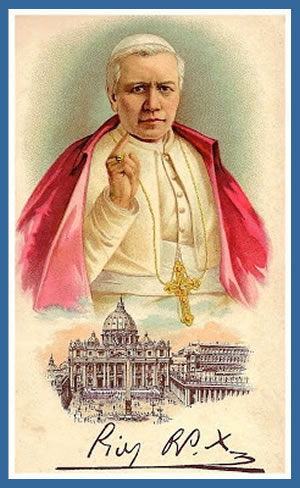

Motu Proprio promulgated by Pope Pius X on November 22, 1903
I. General Principles
II. The different kinds of Sacred Music
III. The Liturgical Text
IV. External form of the sacred compositions
V. The singers
VI. Organ and instruments
VII. The length of the liturgical chant
VIII. Principal means
IX. Conclusion
Among the cares of the pastoral office, not only of this Supreme Chair, which We, though unworthy, occupy through the inscrutable dispositions of Providence, but of every local church, a leading one is without question that of maintaining and promoting the decorum of the House of God in which the august mysteries of religion are celebrated, and where the Christian people assemble to receive the grace of the Sacraments, to assist at the Holy Sacrifice of the Altar, to adore the most august Sacrament of the Lord’s Body and to unite in the common prayer of the Church in the public and solemn liturgical offices. Nothing should have place, therefore, in the temple calculated to disturb or even merely to diminish the piety and devotion of the faithful, nothing that may give reasonable cause for disgust or scandal, nothing, above all, which directly offends the decorum and sanctity of the sacred functions and is thus unworthy of the House of Prayer and of the Majesty of God. We do not touch separately on the abuses in this matter which may arise. Today Our attention is directed to one of the most common of them, one of the most difficult to eradicate, and the existence of which is sometimes to be deplored in places where everything else is deserving of the highest praise — the beauty and sumptuousness of the temple, the splendor and the accurate performance of the ceremonies, the attendance of the clergy, the gravity and piety of the officiating ministers. Such is the abuse affecting sacred chant and music. And indeed, whether it is owing to the very nature of this art, fluctuating and variable as it is in itself, or to the succeeding changes in tastes and habits with the course of time, or to the fatal influence exercised on sacred art by profane and theatrical art, or to the pleasure that music directly produces, and that is not always easily contained within the right limits, or finally to the many prejudices on the matter, so lightly introduced and so tenaciously maintained even among responsible and pious persons, the fact remains that there is a general tendency to deviate from the right rule, prescribed by the end for which art is admitted to the service of public worship and which is set forth very clearly in the ecclesiastical Canons, in the Ordinances of the General and Provincial Councils, in the prescriptions which have at various times emanated from the Sacred Roman Congregations, and from Our Predecessors the Sovereign Pontiffs.
It is with real satisfaction that We acknowledge the large amount of good that has been effected in this respect during the last decade in this Our fostering city of Rome, and in many churches in Our country, but in a more especial way among some nations in which illustrious men, full of zeal for the worship of God, have, with the approval of the Holy See and under the direction of the Bishops, united in flourishing Societies and restored sacred music to the fullest honor in all their churches and chapels. Still the good work that has been done is very far indeed from being common to all, and when We consult Our own personal experience and take into account the great number of complaints that have reached Us during the short time that has elapsed since it pleased the Lord to elevate Our humility to the supreme summit of the Roman Pontificate, We consider it Our first duty, without further delay, to raise Our voice at once in reproof and condemnation of all that is seen to be out of harmony with the right rule above indicated, in the functions of public worship and in the performance of the ecclesiastical offices. Filled as We are with a most ardent desire to see the true Christian spirit flourish in every respect and be preserved by all the faithful, We deem it necessary to provide before anything else for the sanctity and dignity of the temple, in which the faithful assemble for no other object than that of acquiring this spirit from its foremost and indispensable font, which is the active participation in the most holy mysteries and in the public and solemn prayer of the Church. And it is vain to hope that the blessing of heaven will descend abundantly upon us, when our homage to the Most High, instead of ascending in the odor of sweetness, puts into the hand of the Lord the scourges wherewith of old the Divine Redeemer drove the unworthy profaners from the Temple.
Hence, in order that no one for the future may be able to plead in excuse that he did not clearly understand his duty and that all vagueness may be eliminated from the interpretation of matters which have already been commanded, We have deemed it expedient to point out briefly the principles regulating sacred music in the functions of public worship, and to gather together in a general survey the principal prescriptions of the Church against the more common abuses in this subject. We do therefore publish, motu proprio and with certain knowledge, Our present Instruction to which, as to a juridical code of sacred music (quasi a codice giuridice della musica sacra), We will with the fullness of Our Apostolic Authority that the force of law be given, and We do by Our present handwriting impose its scrupulous observance on all.
Instruction on Sacred Music
I General principles
- Sacred music, being a complementary part of the solemn liturgy, participates in the general scope of the liturgy, which is the glory of God and the sanctification and edification of the faithful. It contributes to the decorum and the splendor of the ecclesiastical ceremonies, and since its principal office is to clothe with suitable melody the liturgical text proposed for the understanding of the faithful, its proper aim is to add greater efficacy to the text, in order that through it the faithful may be the more easily moved to devotion and better disposed for the reception of the fruits of grace belonging to the celebration of the most holy mysteries.
- Sacred music should consequently possess, in the highest degree, the qualities proper to the liturgy, and in particular sanctity and goodness of form, which will spontaneously produce the final quality of universality.
It must be holy, and must, therefore, exclude all profanity not only in itself, but in the manner in which it is presented by those who execute it.
It must be true art, for otherwise it will be impossible for it to exercise on the minds of those who listen to it that efficacy which the Church aims at obtaining in admitting into her liturgy the art of musical sounds.
But it must, at the same time, be universal in the sense that while every nation is permitted to admit into its ecclesiastical compositions those special forms which may be said to constitute its native music, still these forms must be subordinated in such a manner to the general characteristics of sacred music that nobody of any nation may receive an impression other than good on hearing them.
II. The different kinds of sacred music
- These qualities are to be found, in the highest degree, in Gregorian Chant, which is, consequently the Chant proper to the Roman Church, the only chant she has inherited from the ancient fathers, which she has jealously guarded for centuries in her liturgical codices, which she directly proposes to the faithful as her own, which she prescribes exclusively for some parts of the liturgy, and which the most recent studies have so happily restored to their integrity and purity.
On these grounds Gregorian Chant has always been regarded as the suprememodel for sacred music, so that it is fully legitimate to lay down thefollowing rule: the more closely a composition for church approaches in its movement, inspiration and savor the Gregorian form, the more sacred and liturgical it becomes; and the more out of harmony it is with that supreme model, the less worthy it is of the temple.
The ancient traditional Gregorian Chant must, therefore, in a large measure be restored to the functions of public worship, and the fact must be accepted by all that an ecclesiastical function loses none of its solemnity when accompanied by this music alone.
Special efforts are to be made to restore the use of the Gregorian Chant by the people, so that the faithful may again take a more active part in the ecclesiastical offices, as was the case in ancient times.
- The above-mentioned qualities are also possessed in an excellent degree by Classic Polyphony, especially of the Roman School, which reached its greatest perfection in the sixteenth century, owing to the works of Pierluigi da Palestrina, and continued subsequently to produce compositions of excellent quality from a liturgical and musical standpoint. Classic Polyphony agrees admirably with Gregorian Chant, the supreme model of all sacred music, and hence it has been found worthy of a place side by side with Gregorian Chant, in the more solemn functions of the Church, such as those of the Pontifical Chapel. This, too, must therefore be restored largely in ecclesiastical functions, especially in the more important basilicas, in cathedrals, and in the churches and chapels of seminaries and other ecclesiastical institutions in which the necessary means are usually not lacking.
- The Church has always recognized and favored the progress of the arts, admitting to the service of religion everything good and beautiful discovered by genius in the course of ages — always, however, with due regard to the liturgical laws. Consequently modern music is also admitted to the Church, since it, too, furnishes compositions of such excellence, sobriety and gravity, that they are in no way unworthy of the liturgical functions.
Still, since modern music has risen mainly to serve profane uses, greater care must be taken with regard to it, in order that the musical compositions of modern style which are admitted in the Church may contain nothing profane, be free from reminiscences of motifs adopted in the theaters, and be not fashioned even in their external forms after the manner of profane pieces.
- Among the different kinds of modern music, that which appears less suitable for accompanying the functions of public worship is the theatrical style, which was in the greatest vogue, especially in Italy, during the last century. This of its very nature is diametrically opposed to Gregorian Chant and classic polyphony, and therefore to the most important law of all good sacred music. Besides the intrinsic structure, the rhythm and what is known as the conventionalism of this style adapt themselves but badly to the requirements of true liturgical music.
III. The liturgical text
- The language proper to the Roman Church is Latin. Hence it is forbidden to sing anything whatever in the vernacular in solemn liturgical functions — much more to sing in the vernacular the variable or common parts of the Mass and Office.
- As the texts that may be rendered in music, and the order in which they are to be rendered, are determined for every liturgical function, it is not lawful to confuse this order or to change the prescribed texts for others selected at will, or to omit them either entirely or even in part, unless when the rubrics allow that some versicles of the text be supplied with the organ, while these versicles are simply recited in the choir. However, it is permissible, according to the custom of the Roman Church, to sing a motet to the Blessed Sacrament after the Benedictus in a solemn Mass. It is also permitted, after the Offertory prescribed for the mass has been sung, to execute during the time that remains a brief motet to words approved by the Church.
- The liturgical text must be sung as it is in the books, without alteration or inversion of the words, without undue repetition, without breaking syllables, and always in a manner intelligible to the faithful who listen.
IV. External form of the sacred compositions
- The different parts of the mass and the Office must retain, even musically, that particular concept and form which ecclesiastical tradition has assigned to them, and which is admirably brought out by Gregorian Chant. The method of composing an introit, a gradual, an antiphon, a psalm, a hymn, a Gloria in excelsis, etc., must therefore be distinct from one another.
- In particular the following rules are to be observed:
(a) The Kyrie, Gloria, Credo, etc., of the Mass must preserve the unity of composition proper to the text. It is not lawful, therefore, to compose them in separate movements, in such a way that each of these movements form a complete composition in itself, and be capable of being detached from the rest and substituted by another.
(b) In the office of Vespers it should be the rule to follow the Caeremoniale Episcoporum, which prescribes Gregorian Chant for the psalmody and permits figured music for the versicles of the Gloria Patri and the hymn.
It will nevertheless be lawful on greater solemnities to alternate the Gregorian Chant of the choir with the so called falsi-bordoni or with verses similarly composed in a proper manner.
It is also permissible occasionally to render single psalms in their entirety in music, provided the form proper to psalmody be preserved in such compositions; that is to say, provided the singers seem to be psalmodising among themselves, either with new motifs or with those taken from Gregorian Chant or based upon it.
The psalms known as di concerto are therefore forever excluded and prohibited.
(c) In the hymns of the Church the traditional form of the hymn is preserved. It is not lawful, therefore, to compose, for instance, a Tantum ergo in such wise that the first strophe presents a romanza, a cavatina, an adagio and the Genitori an allegro.
(d) The antiphons of the Vespers must be as a rule rendered with the Gregorian melody proper to each. Should they, however, in some special case be sung in figured music, they must never have either the form of a concert melody or the fullness of a motet or a cantata.
V. The singers
- With the exception of the melodies proper to the celebrant at the altar and to the ministers, which must be always sung in Gregorian Chant, and without accompaniment of the organ, all the rest of the liturgical chant belongs to the choir of levites, and, therefore, singers in the church, even when they are laymen, are really taking the place of the ecclesiastical choir. Hence the music rendered by them must, at least for the greater part, retain the character of choral music.
By this it is not to be understood that solos are entirely excluded. But solo singing should never predominate to such an extent as to have the greater part of the liturgical chant executed in that manner; the solo phrase should have the character or hint of a melodic projection (spunto), and be strictly bound up with the rest of the choral composition.
On the same principle it follows that singers in church have a real liturgical office, and that therefore women, being incapable of exercising such office, cannot be admitted to form part of the choir. Whenever, then, it is desired to employ the acute voices of sopranos and contraltos, these parts must be taken by boys, according to the most ancient usage of the Church.
Finally, only men of known piety and probity of life are to be admitted to form part of the choir of a church, and these men should by their modest and devout bearing during the liturgical functions show that they are worthy of the holy office they exercise. It will also be fitting that singers while singing in church wear the ecclesiastical habit and surplice, and that they be hidden behind gratings when the choir is excessively open to the public gaze.
VI. Organ and instruments
- Although the music proper to the Church is purely vocal music, music with the accompaniment of the organ is also permitted. In some special cases, within due limits and with proper safeguards, other instruments may be allowed, but never without the special permission of the Ordinary, according to prescriptions of the Caeremoniale Episcoporum.
- As the singing should always have the principal place, the organ or other instruments should merely sustain and never oppress it.
- It is not permitted to have the chant preceded by long preludes or to interrupt it with intermezzo pieces.
- The sound of the organ as an accompaniment to the chant in preludes, interludes, and the like must be not only governed by the special nature of the instrument, but must participate in all the qualities proper to sacred music as above enumerated.
- The employment of the piano is forbidden in church, as is also that of noisy or frivolous instruments such as drums, cymbals, bells and the like.
- It is strictly forbidden to have bands play in church, and only in special cases with the consent of the Ordinary will it be permissible to admit wind instruments, limited in number, judiciously used, and proportioned to the size of the placeprovided the composition and accompaniment be written in grave and suitable style, and conform in all respects to that proper to the organ.
- In processions outside the church the Ordinary may give permission for a band, provided no profane pieces be executed. It would be desirable in such cases that the band confine itself to accompanying some spiritual canticle sung in Latin or in the vernacular by the singers and the pious associations which take part in the procession.
VII. The length of the liturgical chant
- It is not lawful to keep the priest at the altar waiting on account of the chant or the music for a length of time not allowed by the liturgy. According to the ecclesiastical prescriptions the Sanctus of the Mass should be over before the elevation, and therefore the priest must here have regard for the singers. The Gloria and the Credo ought, according to the Gregorian tradition, to be relatively short.
- In general it must be considered a very grave abuse when the liturgy in ecclesiastical functions is made to appear secondary to and in a manner at the service of the music, for the music is merely a part of the liturgy and its humble handmaid.
VIII. Principal means
- For the exact execution of what has been herein laid down, the Bishops, if they have not already done so, are to institute in their dioceses a special Commission composed of persons really competent in sacred music, and to this Commission let them entrust in the manner they find most suitable the task of watching over the music executed in their churches. Nor are they to see merely that the music is good in itself, but also that it is adapted to the powers of the singers and be always well executed.
- In seminaries of clerics and in ecclesiastical institutions let the above-mentioned traditional Gregorian Chant be cultivated by all with diligence and love, according to the Tridentine prescriptions, and let the superiors be liberal of encouragement and praise toward their young subjects. In like manner let a Schola Cantorum be established, whenever possible, among the clerics for the execution of sacred polyphony and of good liturgical music.
- In the ordinary lessons of Liturgy, Morals, and Canon Law given to the students of theology, let care be taken to touch on those points which regard more directly the principles and laws of sacred music, and let an attempt be made to complete the doctrine with some particular instruction in the aesthetic side of sacred art, so that the clerics may not leave the seminary ignorant of all those subjects so necessary to a full ecclesiastical education.
- Let care be taken to restore, at least in the principal churches, the ancient Scholae Cantorum, as has been done with excellent fruit in a great many places. It is not difficult for a zealous clergy to institute such Scholae even in smaller churches and country parishesnay, in these last the pastors will find a very easy means of gathering around them both children and adults, to their own profit and the edification of the people.
- Let efforts be made to support and promote, in the best way possible, the higher schools of sacred music where these already exist, and to help in founding them where they do not. It is of the utmost importance that the Church herself provide for the instruction of her choirmasters, organists, and singers, according to the true principles of sacred art.
IX. Conclusion
- Finally, it is recommended to choirmasters, singers, members of the clergy, superiors of seminaries, ecclesiastical institutions, and religious communities, parish priests and rectors of churches, canons of collegiate churches and cathedrals, and, above all, to the diocesan ordinaries to favor with all zeal these prudent reforms, long desired and demanded with united voice by all; so that the authority of the Church, which herself has repeatedly proposed them, and now inculcates them, may not fall into contempt.
Given from Our Apostolic Palace at the Vatican, on the day of the Virgin and martyr, Saint Cecilia, November 22, 1903, in the first year of Our Pontificate.
Pius X, Pope.
Papal Letter to the Cardinal Vicar of Rome – December 8, 1903
The carrying out of the above regulations for the restoration of sacred music is laid upon Cardinal Respighi, Vicar-General of Rome, in the following letter from His Holiness, Pope Pius X.
Lord Cardinal,
A desire to see the decorum, dignity and holiness of the liturgical functions flourishing again in all places has determined Us to make known by a special writing under Our own hand Our will with regard to the sacred music which is employed in the service of public worship. We cherish the hope that all will second Us in this desired restoration, not merely with that blind submission, always laudable though it be, which is accorded out of a pure spirit of obedience to commands that are onerous and contrary to one’s own manner of thinking and feeling, but with that alacrity of will which springs from the intimate persuasion of having to do so on grounds duly weighed, clear, evident, and beyond question.
Even a little reflection on the end for which art is admitted to the service of public worship, and on the supreme fitness of offering to the Lord only things in themselves good, and where possible excellent, will at once serve to show that the prescriptions of the Church regarding sacred music are but the immediate application of those two fundamental principles. When the clergy and choirmasters are penetrated with them, good sacred music flourishes spontaneously, as has been constantly observed, and continues to be observed in a great many places; when on the contrary those principles are neglected, neither prayers, admonitions, severe and repeated orders nor threats of canonical penalties suffice to effect any change; for passion, and when not passion a shameful and inexcusable ignorance, always finds a means of eluding the will of the Church, and continuing for years in the same reprehensible way.
This alacrity of will We look for in a very special way among the clergy and faithful of this beloved City of Rome, the center of Christendom and the seat of the Supreme Authority of the Church. Indeed it would seem but natural that none should feel more deeply the influence of Our word than those who hear it directly from our mouth, and that the example of loving and filial submission to Our fatherly invitations should be given with greater solicitude by none more than by that first and most noble portion of the flock of Christ, the Church of Rome, which has been specially entrusted to Our pastoral care as Bishop. Besides, This example is to be given in the sight of the whole world. Bishops and the faithful are continually coming here from all lands to honor the Vicar of Christ and to renew their spirit by visiting our venerable basilicas and the tombs of the martyrs, and by assisting with redoubled fervor at the solemnities which are here celebrated with all pomp and splendor throughout the year. “Optamus ne moribus nostris offensi recedant,” said Our predecessor Benedict XIV in his own time in his Encyclical Letter Annus qui, speaking of this very subject of sacred music: “We desire that they may not return to their own countries scandalized by our customs.”
And farther on, touching on the abuse of instruments which then prevailed, the same Pontiff said: “What opinion will be formed of us by those, who, coming from countries in which instruments are not used in church, hear them in our churches, just as they might in theaters and other profane places? They will come, too, from places and countries where there is singing and music in the churches of the same king as in ours. But if they are persons of sound judgment, they must be grieved not to find in our music that remedy for the evil in their own churches which they came hither to seek.” In other times the contradiction between the music usually executed in the churches and the ecclesiastical laws and prescriptions was, perhaps, far less noticeable, and the scandal caused by this contradiction was doubtless more circumscribed, precisely because the evil was more widely diffused and general. But now that so much study has been employed by distinguished men in explaining the liturgy and the art used in the service of public worship, now that such consoling, and not infrequently, such splendid results have been obtained in so many churches throughout the world in the restoration of sacred music, notwithstanding the very serious difficulties that had to be faced, and that have been happily overcome; now, in fine, that the necessity of a complete change in the order of things has come to be universally appreciated, every abuse in this matter becomes intolerable, and must be removed.
You, therefore, Lord cardinal, in your high office as Our Vicar in Rome for spiritual matters, will, We are sure, exert yourself with the gentleness that is characteristic of you, but with equal firmness, to the end that the music executed in the churches and the chapels of the secular and regular clergy of this City may be in entire harmony with Our instructions. There is much to be corrected or removed in the chants of the mass, of the Litany of Loretto, of the Eucharistic hymn, but that which needs a thorough renewal is the singing of the Vespers of the feasts celebrated in the different churches and basilicas. The liturgical prescriptions of the Caeremoniale Episcoporum and the beautiful musical traditions of the classical Roman school are no longer to be found. For the devout psalmody of the clergy, in which the people also used to join, there have been substituted interminable musical compositions on the words of the psalms, all of them modeled on old theatrical works, and most of them of such meager artistic value that they would not be tolerated for a moment even in our second-rate concerts. It is certain that Christian piety and devotion are not promoted by them; the curiosity of some of the less intelligent is fed, but the majority, disgusted and scandalized, wonder how it is that such an abuse can still survive. We therefore wish the cause to be completely extirpated, and that the solemnity of Vespers should be celebrated according to the liturgical rules indicated by Us. The Patriarchal basilicas will lead the way by the example of solicitous care and enlightened zeal of the Lord cardinals who preside over them, and with these will vie especially the minor basilicas, and the collegiate and parochial churches, as well as the churches and chapels of the religious orders. And do you Lord cardinal, neither accept excuses nor concede delays. The difficulty is not diminished but rather augmented by postponement, and since the thing is to be done, let it be done immediately and resolutely. Let all have confidence in Us and in Our word, with which heavenly grace and blessing are united. At first the novelty will produce some wonder among individuals; here and there a leader or director of a choir may find himself somewhat unprepared; but little by little things will right themselves, and in the perfect harmony between the music with the liturgical rules and the nature of the psalmody all will discern a beauty and a goodness which have perhaps never been observed. The Vespers service will indeed be notably shortened. But if the rectors of the churches desire on a special occasion to prolong the function somewhat. in order to detain the people who are wont so laudably to go in the evening to the particular church where the feast is being celebrated, there is nothing to hinder themnay, it will rather be so much gained for the piety and edification of the faithful — if they have a suitable sermon after the Vespers, closed with Solemn Benediction of the Most Holy Sacrament.
Finally, We desire that sacred music be cultivated with special care and in the proper way in all the seminaries and ecclesiastical colleges of Rome, in which such a large and choice body of young clerics from all parts of the world are being educated in the sacred sciences and in the ecclesiastical spirit. We know, and We are greatly comforted by the knowledge, that in some institutions sacred music is in such a flourishing condition that it may serve as a model for others. But there are some seminaries and colleges which leave much to be desired owing to the carelessness of the superiors, or the want of capacity and the imperfect taste of the persons to whom the teaching of chant and the direction of sacred music is entrusted. You, Lord Cardinal, will be good enough to provide a remedy for this also with solicitude, by insisting especially that Gregorian Chant, according to the prescriptions of the Council of Trent and of innumerable other councils, provincial and diocesan in all parts of the world, be studied with particular diligence, and be as a rule preferred in the public and private functions of the institute. It is true that in other times Gregorian Chant was known to most people only through books which were incorrect, vitiated and curtailed. But the accurate and prolonged study that has been given to it by illustrious men who have done a great service to sacred art has changed the face of things. Gregorian Chant restored in such a satisfactory way to its early purity, as it was handed down by the fathers and is found in the codices of the various churches, is sweet, soft, easy to learn and of a beauty so fresh and full of surprises that wherever it has been introduced it has never failed to excite real enthusiasm in the youthful singers. Now, when delights enters into the fulfillment of duty, everything is done with greater alacrity and with more lasting fruit. It is Our will, therefore, that in all seminaries and colleges in this fostering city there be introduced once more the most ancient Roman chant which used to resound in our churches and basilicas and which formed the delight of past generations in the fairest days of Christian piety. And as in former times the chant was spread abroad over the whole Western Church from Rome, so We desire that Our young clerics, educated under Our own eyes, may carry it with them and diffuse it again in their own dioceses when they return thither as priests to work for the glory of God. We are overjoyed to be able to give these regulations at a time when We are about to celebrate the 15th centenary of the death of the glorious and incomparable Pontiff St. Gregory the Great, to whom an ecclesiastical tradition dating back many centuries has attributed the composition of these sacred melodies and from whom they have derived their name. Let Our dearly-beloved youths exercise themselves in them, for it will be sweet to us to hear them when, as We have been told will be the case, they will assemble at the coming centenary celebrations round the tomb of the Holy Pontiff in the Vatican Basilica during the Sacred Liturgy which, please God, will be celebrated by Us on that auspicious occasion.
Meanwhile as a pledge of Our particular benevolence, receive, Lord Cardinal, the Apostolic Benediction, which from the bottom of Our heart We impart to you, to the clergy, and to all Our most beloved people.
From the Vatican on the Feast of the Immaculate Conception of 1903.
Pius X, Pope

-
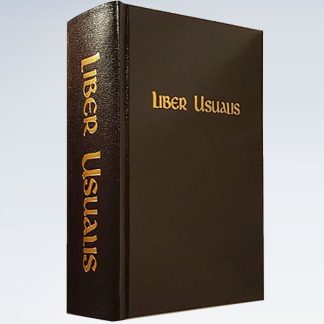 Liber Usualis (№ 801 With Introduction and Rubrics in English)US$ 100.00
Liber Usualis (№ 801 With Introduction and Rubrics in English)US$ 100.00 -
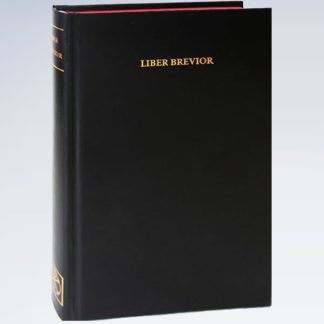 Liber Brevior (Traditional Latin Mass Chant Book)US$ 55.00
Liber Brevior (Traditional Latin Mass Chant Book)US$ 55.00 -
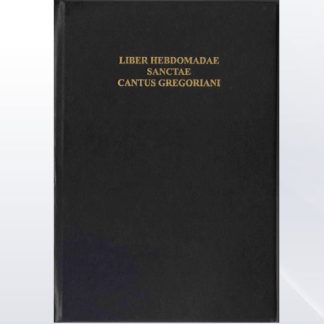 Liber Hebdomadae Sanctae Cantus Gregoriani (Holy Week Gregorian Chant)US$ 22.00
Liber Hebdomadae Sanctae Cantus Gregoriani (Holy Week Gregorian Chant)US$ 22.00 -
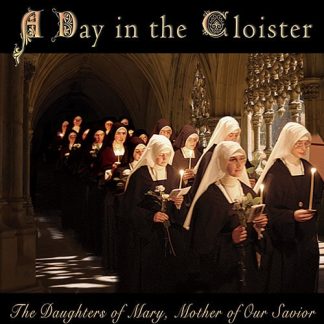 A Day in the Cloister by the Daughters of Mary (Gregorian Chant and Prayer CD)US$ 19.00
A Day in the Cloister by the Daughters of Mary (Gregorian Chant and Prayer CD)US$ 19.00 -
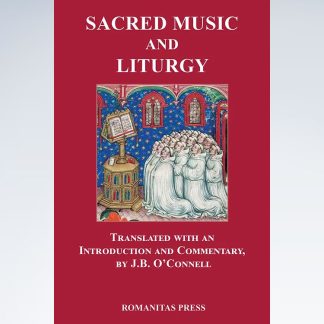 Sacred Music and LiturgyUS$ 17.00
Sacred Music and LiturgyUS$ 17.00 -
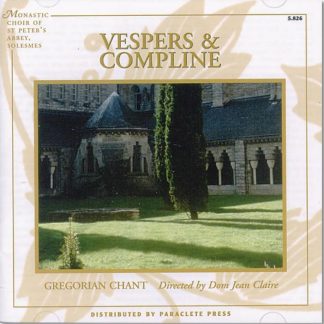 Vespers and Compline (in Gregorian chant)US$ 22.00
Vespers and Compline (in Gregorian chant)US$ 22.00
VIRGÓ SACRÁTA is a Christian mission-driven online resource and shop inspired from the beauty of Catholic faith, tradition, and arts. Our mission is to “Restore All Things to Christ!”, in continuing the legacy of Pope St. Pius X under the patronage of the Blessed Virgin Mary. “Who is she that cometh forth as the morning rising, fair as the moon, bright as the sun, terrible as an army set in battle array?” O Mary, conceived without sin, pray for us who have recourse to Thee.


